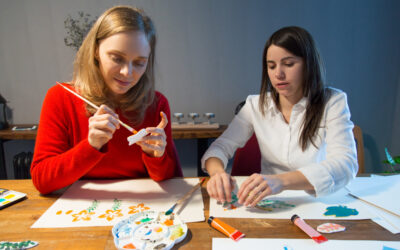The Creative Path to Emotional Well-being
Art therapy is a unique and powerful form of psychotherapy that harnesses the healing potential of artistic expression. It provides individuals with a creative outlet to explore their thoughts, emotions, and experiences while working towards emotional well-being and self-discovery. In this introduction to art therapy, we’ll explore what it is, how it works, and the benefits it can offer.
What is Art Therapy?
- The Therapeutic Use of Art: Art therapy is a mental health profession that utilizes the creative process of art-making to improve and enhance the mental, emotional, and physical well-being of individuals.
- Creative Expression: Art therapy encourages individuals to express themselves through various art forms, such as painting, drawing, sculpture, or even digital media.
- Therapeutic Relationship: It typically involves a trained art therapist who guides and supports clients in their creative journey.
How Does Art Therapy Work?
- Unlocking the Subconscious: Art therapy provides a non-verbal means of communication, allowing individuals to delve into their subconscious and explore complex feelings and experiences.
- Symbolism: Art often contains symbols and metaphors that reveal hidden emotions and thoughts.
- Catharsis: The act of creating art can release pent-up emotions and provide relief.
Benefits of Art Therapy:
- Art as a Healing Tool: Art therapy offers a wide range of benefits for individuals dealing with various emotional and psychological challenges.
- Emotional Release: Art provides a safe space to express and process difficult emotions, such as grief, trauma, or anxiety.
- Self-Exploration: Through art, individuals can gain insight into their thoughts, feelings, and patterns of behavior.
- Stress Reduction: Engaging in creative activities can reduce stress and promote relaxation.
- Enhanced Communication: For those who struggle with verbal communication, art serves as an alternative means of expression.
- Improved Self-Esteem: Achieving artistic goals and creating meaningful art can boost self-confidence and self-esteem.
- Empowerment: Art therapy empowers individuals by giving them a sense of control over their creative process and emotions.
Who Can Benefit from Art Therapy?
- Broad Applicability: Art therapy is a versatile approach that can be beneficial for individuals of all ages and backgrounds.
- Children and Adolescents: Art therapy can help young people navigate emotional challenges, trauma, or developmental issues.
- Adults: It’s effective for adults dealing with stress, grief, relationship difficulties, and personal growth.
- Seniors: Art therapy can improve the quality of life for older adults by promoting cognitive function and emotional well-being.
- Special Needs: It’s used to support individuals with developmental disabilities, mental health disorders, and physical disabilities.
The Role of the Art Therapist:
- Guiding the Creative Process: Certified art therapists are trained professionals who facilitate the therapeutic process.
- Assessment: Art therapists evaluate clients’ needs and tailor art interventions accordingly.
- Creating a Safe Environment: They provide a safe and non-judgmental space for clients to express themselves.
- Interpreting Art: Art therapists help clients explore the meaning behind their art and guide discussions on their creative work.
- Treatment Planning: They develop personalized treatment plans to address specific emotional and psychological goals.
Art Therapy Approaches:
- Tailored to Individual Needs: Art therapists employ various approaches depending on the client’s objectives and preferences.
- Gestalt Art Therapy: Focuses on the present moment and the client’s experience in the art-making process.
- Person-Centered Art Therapy: Emphasizes the importance of self-expression and self-discovery.
- Analytical Art Therapy: Explores the symbolism and meaning behind the artwork.
Getting Started with Art Therapy:
- Exploring Your Creative Journey: If you’re interested in art therapy, you can start by seeking a certified art therapist or exploring art on your own.
- Professional Guidance: Find a certified art therapist who can guide you through the process and tailor interventions to your needs.
- Self-Expression: Begin creating art on your own as a form of self-expression and self-discovery.
Art therapy is a profound and versatile tool for healing and self-exploration. It allows individuals to tap into their creative potential and unlock the healing power of artistic expression. Whether you’re looking to process difficult emotions, enhance your self-awareness, or simply explore your creative side, art therapy offers a therapeutic and transformative journey toward emotional well-being and personal growth.

Jass
Jass earned her bachelor’s degree in Computer Science, transitioning into a profession as a content writer. With a keen mastery of words, she takes pleasure in expressing her thoughts and ideas creatively. Her ability to captivate audiences with her imaginative write-ups stands out as one of her notable strengths.



